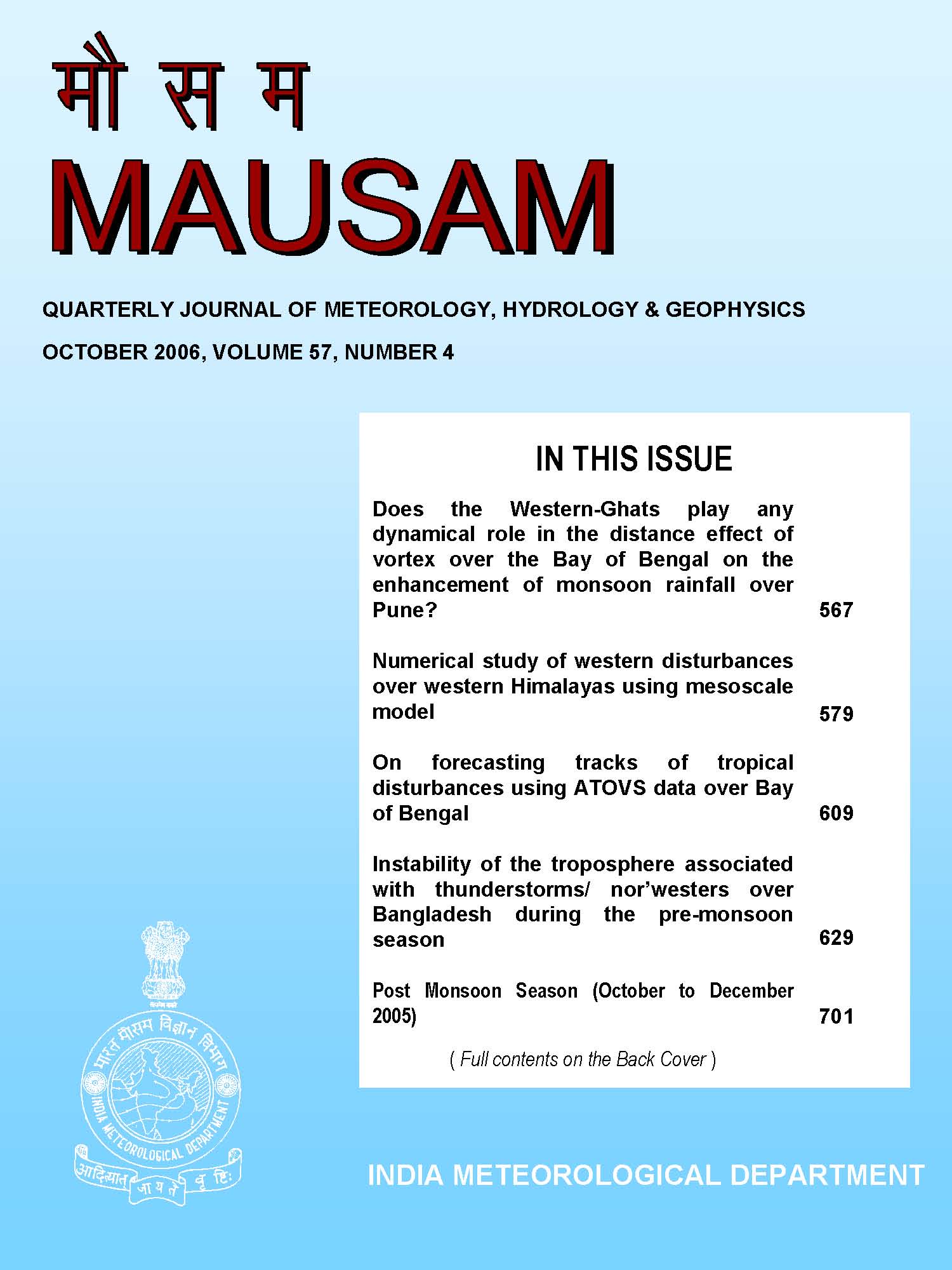Ozone variations pertaining to dry and wet monsoon seasons over Indian region
DOI:
https://doi.org/10.54302/mausam.v57i4.505Abstract
’kq"d vkSj vknzZ ekulwu o"kkZsa ds nkSjku Vh-lh-vks- forj.k dk v/;;u djus ds fy, Hkkjrh; {ks+= esa o"kZ 1982]1983]1987 ,oa 1988 ds dqy dkWye vkstksu ¼Vh-lh-vks-½ ds ekfld vkSlr dk mi;ksx fd;k x;k gS A bl ’kks/k&Ik= esa mDr o"kksZa ds Hkkjr ds 13 LVs’kuksa ds Vh-lh-vks- vkadM+ksa dk v/;;u fd;k x;k gSA ’kq"d vkSj vknzZ ekulwu o"kksZa ds nkSjku Vh-lh-vks- forj.k dh rqyuk ls ;g irk pyk gS fd Vh-lh-vks- ds eku vknZz o"kksZa dh rqyuk esa ’kq"d o"kksZa esa vf/kd ik, x, gSaA Vh-lh-vks- esa ifjorZu gksuk ’kq"d ,oa vknzZ o"kksZa ds nkSjku laoguh; xfrfof/k esa fHkUurk dks ekuk tk ldrk gSA ’kq"d ¼vknzZ½ o"kksZa ds nkSjku laogu esa deh ¼o`f)½ Vh-lh-vks- dh ek=k dks c<+krh ?kVkrh gSA ’kq"d ,oa vknzZ o"kksZa ds chp ds ekulwu ds eghuksa ds nkSjku Vh-lh-vks- ds egRo dh tk¡p djus ds fy, lkaf[;dh; Vh--VsLV dk iz;ksx fd;k x;k gSA ;g varj nene dks NksM+dj vU; lHkh LVs’kuksa ds fy, lkaf[;dh; n`f"V ls 5 izfr’kr rd egRoiw.kZ gSA ,slk dgk tk ldrk gS fd Hkkjr esa xzh"edkyhu ekulwu eghuksa ds nkSjku vks-,y-vkj- rFkk Vh-lh-vks- ds chp vPNs laca/k jgs gSa D;ksafd bl vof/k ds nkSjku laogu dkQh izcy jgk gS A
Monthly mean total column ozone (TCO) over Indian region for the years 1982, 1983, 1987 and 1988 has been utilized to study the TCO distribution during dry and wet monsoon years. TCO data for 13 Indian stations for the above years have been considered in the study. Comparison of TCO distribution during dry and wet monsoon years suggested that TCO values are found higher during dry years than those in wet years. The changes in TCO may be attributed to difference in convective activity during dry and wet years. The suppressed (enhanced) convection during dry (wet) years may lead to increase (decrease) in TCO.
The statistical t-test is applied to test the significance of TCO difference during monsoon months between dry and wet years. The difference is statistically significant at 5% level of confidence for all stations except Dumdum. It can be said that the relation between OLR and TCO holds good during Indian summer monsoon months, as convection is stronger during this period.
Downloads
Published
How to Cite
Issue
Section
License
Copyright (c) 2021 MAUSAM

This work is licensed under a Creative Commons Attribution-NonCommercial 4.0 International License.
All articles published by MAUSAM are licensed under the Creative Commons Attribution 4.0 International License. This permits anyone.
Anyone is free:
- To Share - to copy, distribute and transmit the work
- To Remix - to adapt the work.
Under the following conditions:
- Share - copy and redistribute the material in any medium or format
- Adapt - remix, transform, and build upon the material for any purpose, even
commercially.



